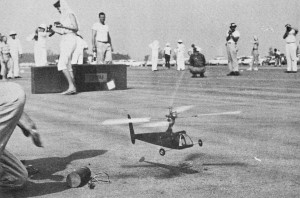|
An
extensive article introducing non-modelers to aircraft modeling appeared
in the Annual Edition of the 1962 American Modeler magazine. 15 pages were
devoted to describing just about every aspect of model building and flying
- free flight gas and rubber; control line stunt, combat, scale, and speed;
helicopters and ornithopters; indoor gliders, stick and tissue, and microfilm;
even some early radio control. In order to keep page length here
reasonable (because of all the images), the article is broken into a few
pages. Pages: |
10 & 11 |
12|
13
|
14 |
15
|16
|
17 |
18
|
19 |
20
|
21 |
22
|23
|
24 | For Non-Modelers: All About Air Modeling
20 Easy Ways to Go Crazy! <previous>

Electric power planes have made an appearance in recent years. Light
free flight above is molded from expanded plastic. Tiny D.C. motor runs
off one-shot battery.

Original design helicopter [above] uses .074 glow engine for power.
Flew well.
The object of Indoor flying is maximum endurance - and what endurance! The
1960 record stands at 37 min. 32 sec., and this was done with a model having
a 44 in. wingspan, weighing .058 oz. (slightly over five one-hundredths
of an ounce). Fifteen and twenty minute flights are not unusual in average
conditions with most types of indoor models. Thus an indoor model
is of superlight construction. The barest outline structures are of 1/64"
and 1/32" sq. balsa. Covering is gossamer transparent "microfilm" (resembling
cellophane but thinner and lighter). These extremely delicate structures
are braced with tungsten or nichrome wire of one one-thousandths inch diameter.
Power consists of a single loop of threadlike rubber wound 1,000 to
2,000 turns swinging a propeller having diameter equal to half the model's
wingspan. Props are also built-up and microfilm covered like rest of structure.
The most incredible aspect of indoor modeling is the slow-motion
pace of the entire activity. Models fly at the equivalent speed of a very
slow walk. The large props barely tick over and rpm is easily counted visually.
The length of the motor run is ideally nearly equal to the flight duration.
A flight consists of very slow circling climb to near ceiling contact with
gradual circling descent as the rubber motor power slowly diminishes.
Because of the extremely delicate structures special carrying boxes
must be built to transport an indoor model. Simply opening the box lid takes
on the appearance of a slow-motion ritual. Flying conditions inside the
hangar or convention hall require that all doors and windows remain closed
to prevent even the slightest stray breeze from disturbing the dead-still
air desired. Modelers and spectators must move about very, very slowly near
the models to prevent turbulence caused by their bodies' motion. An Ill-aimed
sneeze can almost destroy an indoor model! Obviously building and
flying indoor models requires a high degree of skill and unlimited patience.
Indoor addicts are few In number but their dedication is complete. A small
but ever-constant part of the model picture since the early 1930's, the
activity in recent years has attracted more and more serious-minded advanced
modelers. Indoor model types are divided into several classes by
A.M.A. regulations. These include both stick and cabin type models, paper
and microfilm covered, also R.O.G., hand-launched and R.O.W. There are also
categories . for Autogiro, Ornithopter and Helicopter, but these types have
very limited interest. Classification is according to area of supporting
surfaces: Class A, 30 sq. in. max.; Class B 30 to 100 sq. in.; Class C 100
to 150 sq. in.; and Class D, 150 to 300 sq. in. There is also a class for
indoor hand-launched gliders having no more than 100 sq. in. area of supporting
surface. These are of all-balsa construction like their outdoor counterparts.
Because of the relatively small interest in indoor modeling there
is no wide selection of kits and supplies as with the more conventional
model types. Most models are built from magazine plans and from such sources
as the Zaic Yearbooks. Micro-Dyne Precisian Products, 715 East D St., Ontario,
Calif., is a supply source and California Model Co. has available a kit
for a Class B stick model called the "Featherette." Jetco Models has a simple
R.O.G. ideal for introducing the beginner to indoor flying. Jetco also offers
hand-launched glider kits. Okay, class, any questions?
<previous>
Posted December 25, 2010
|